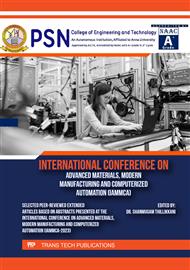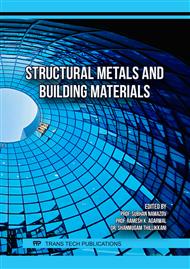[1]
Lundin, C. D. (1982). Dissimilar metal welds-transition joints literature review. Welding Journal, 61(2), 58-63.
Google Scholar
[2]
Missori, S., & Koerber, C. (1997). Laser beam welding of austenitic-ferritic transition joints. Welding Journal-Including Welding Research Supplement, 76(3)..
Google Scholar
[3]
Pan, C., & Zhang, Z. (1996). Morphologies of the transition region in dissimilar austenitic-ferritic welds. Materials Characterization, 36(1), 5-10.
DOI: 10.1016/1044-5803(95)00249-9
Google Scholar
[4]
Omar A (1998) Effects of welding parameters on hard zone formation at dissimilar metal welds. Weld J 77:86s–99s
Google Scholar
[5]
Li, G. F., & Congleton, J. (2000). Stress corrosion cracking of a low alloy steel to stainless steel transition weld in PWR primary waters at 292 C. Corrosion Science, 42(6), 1005-1021.
DOI: 10.1016/s0010-938x(99)00131-6
Google Scholar
[6]
Joseph, A., Ramesh, A. S., Jayakumar, T., &Murugan, N. (2001). Failure Analysis of a Dissimilar Weld Joint in a Steam Generator/Schadensanalyseeiner Schwarz-Weiß-Schweißverbindung in einemDampfgenerator. Practical Metallography, 38(12), 667-679.
DOI: 10.1515/pm-2001-381202
Google Scholar
[7]
Barnhouse, E. J., &Lippold, J. C. (1998). Microstructure/property relationships in dissimilar welds between duplex stainless steels and carbon steels. WELDING JOURNAL-NEW YORK-, 77, 477-s.
Google Scholar
[8]
McPherson, N. A., Chi, K., McLean, M. S., & Baker, T. N. (2003). Structure and properties of carbon steel to duplex stainless steel submerged arc welds. Materials science and technology, 19(2), 219-226..
DOI: 10.1179/026708303225009643
Google Scholar
[9]
Rajeev, R., Samajdar, I., Raman, R., Harendranath, C. S., & Kale, G. B. (2001).Origin of hard and soft zone formation during cladding of austenitic/duplex stainless steel on plain carbon steel. Materials science and technology, 17(8), 1005-1011.
DOI: 10.1179/026708301101510852
Google Scholar
[10]
Kaçar, R., &Acarer, M. (2003). Microstructure–property relationship in explosively welded duplex stainless steel–steel. Materials Science and Engineering: A, 363(1-2), 290-296.
DOI: 10.1016/s0921-5093(03)00643-9
Google Scholar
[11]
Kanemaru, S., Sasaki, T., Sato, T., Mishima, H., Tashiro, S., & Tanaka, M. (2014). Study for TIG–MIG hybrid welding process. Welding in the World, 58(1), 11-18.
DOI: 10.1007/s40194-013-0090-y
Google Scholar
[12]
Temmar, M., Hadji, M., &Sahraoui, T. (2011). Effect of post-weld aging treatment on mechanical properties of Tungsten Inert Gas welded low thickness 7075 aluminium alloy joints. Materials & Design, 32(6), 3532-3536.
DOI: 10.1016/j.matdes.2011.02.011
Google Scholar
[13]
Meng, X., Qin, G., Zhang, Y., Fu, B., & Zou, Z. (2014). High speed TIG–MAG hybrid arc welding of mild steel plate. Journal of Materials Processing Technology, 214(11), 2417-2424.
DOI: 10.1016/j.jmatprotec.2014.05.020
Google Scholar
[14]
Zhang, H. T., Liu, J. H., & Feng, J. C. (2014). Effect of auxiliary TIG arc on formation and microstructures of aluminum alloy/stainless steel joints made by MIG welding-brazing process. Transactions of Nonferrous Metals Society of China, 24(9), 2831-2838.
DOI: 10.1016/s1003-6326(14)63415-4
Google Scholar
[15]
Akbari, D., &Sattari-Far, I. (2009). Effect of the welding heat input on residual stresses in butt-welds of dissimilar pipe joints. International journal of pressure vessels and piping, 86(11), 769-776.
DOI: 10.1016/j.ijpvp.2009.07.005
Google Scholar
[16]
Naje, A. S., Chelliapan, S., Zakaria, Z., & Abbas, S. A. (2015). Treatment performance of textile wastewater using electrocoagulation (EC) process under combined electrical connection of electrodes. Int. J. Electrochem. Sci, 10(7), 5924-5941.
DOI: 10.1016/s1452-3981(23)17305-6
Google Scholar
[17]
Duan, Z., Qin, R., & He, G. (2014). Mass transfer and weld appearance of 316L stainless steel covered electrode during shielded metal arc welding. Metallurgical and Materials Transactions A, 45(2), 843-853.
DOI: 10.1007/s11661-013-2001-7
Google Scholar
[18]
Sun, P., Liu, C., & Xu, J. (2009). Phase field model of thermo-induced marangoni effects in the mixtures and its numerical simulations with mixed finite element method. Communications in Computational Physics, 6(5), 1095..
DOI: 10.4208/cicp.2009.v6.p1095
Google Scholar
[19]
Lu, S., Fujii, H., Sugiyama, H., Tanaka, M., &Nogi, K. (2002). Weld penetration and Marangoni convection with oxide fluxes in GTA welding. Materials Transactions, 43(11), 2926-2931.
DOI: 10.2320/matertrans.43.2926
Google Scholar
[20]
Muthupandi, V., Srinivasan, P. B., Seshadri, S. K., &Sundaresan, S. (2003). Corrosion behaviour of duplex stainless steel weld metals with nitrogen additions. Corrosion engineering, science and technology, 38(4), 303-308.
DOI: 10.1179/147842203225008895
Google Scholar
[21]
N.Mohanraj, N.Mathan Kumar, P.Prathap, P.Ganeshan, K.Raja, V.Mohanavel, Alagar Karthick, M. Muhibbullah, Mechanical Properties and Electrical Resistivity of the Friction Stir Spot-Welded Dissimiliar Al-Cu Joints, International Journal of Polymer Science, 2022, 208-222.
DOI: 10.1155/2022/4130440
Google Scholar



